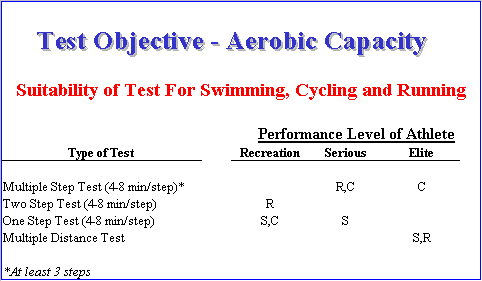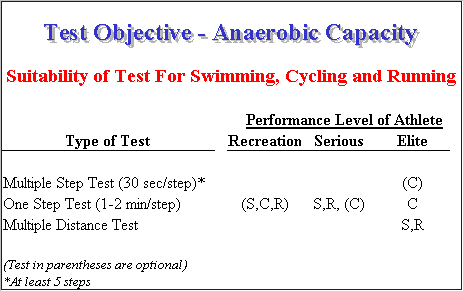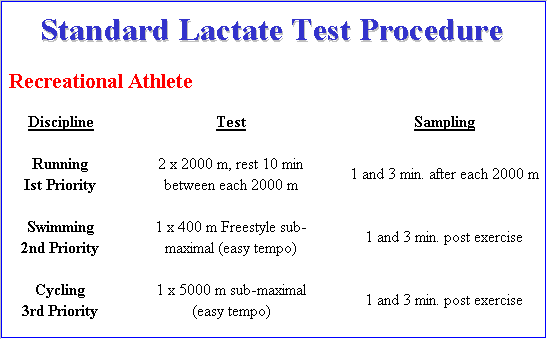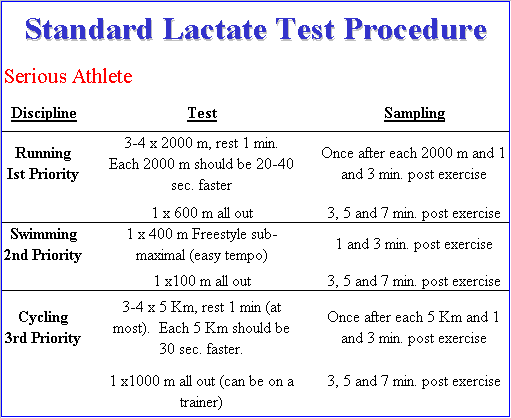
For a triathlete of a moderate performance level (recreational athlete), a simple lactate sample in training like a control test (see below) may be all that is necessary to improve their training. Serious, higher performing athletes will need detailed and diverse information to optimize training and to assure further performance improvement in competition. For elite athletes competing on an international level, a much more complex test protocol is needed to fine-tune their training.
The following sections discuss in the context of the triathlon, different types of lactate tests. Included in this discussion are the information provided by these tests, priorities for testing and protocols recommended for recreational and serious competitors. The use of lactate testing for other sports besides the triathlon would be similar.
We will not discuss in detail the elite athlete. This is one who competes at high performance levels on an international basis. The testing for these athletes is too complex for a discussion here and will be addressed in the future in other publications.
There are two kinds of lactate tests:
- Standard lactate tests - The standard lactate tests are principally used for defining the athlete's conditioning profile. This is needed to deduce guidelines for the next training period. The final choice of the most appropriate standard lactate test procedures (SLTP) will depend on 1) the question you want to be answered by the test and 2) by the performance level of the athlete.
- Control lactate tests - Control tests are mainly meant to verify the implementation of the training guidelines and to adjust the guidelines if necessary. For a recreational athlete, a control lactate test can be used to improve their training.
On the other hand these tests can also be used to get complementary information to the SLTP. These may be very interesting in the pre-competition phase as the athlete get closer to an important event. For example, it is important to know the aerobic power of the athlete as the competition gets nearer. (See Swimming Test 3) According to the question that has to be answered, control lactate tests can consist of any typical training exercises while the standard lactate test procedure has to be carefully chosen.
A lactate test can provide the coach with information on four variables. The following is a short description of these four variables:Aerobic capacity - the peak strength of the aerobic energy supply
Aerobic power - the extent to which the peak strength of the aerobic energy supply is exploited
Anaerobic capacity - the peak strength of the anaerobic energy supply
Anaerobic power - the extent to which the peak strength of the anaerobic energy supply is exploited.
One metabolic parameter is of very low interest for a triathlete. That is anaerobic power. Anaerobic power is of major importance for events between 45 sec and 4 minutes and of lesser interest for competitive events between 5 minutes and 20 minutes. With the exception of some unusual sprint triathlons, training to improve this element is of no use for the triathlete.
A coach or athlete uses both a standard lactate test protocol (SLTP) and control tests to measure these variables. This site will concentrate on tests for two types of athletes which we have designated as recreational and serious athletes. There is a third type of athlete which we designate as elite. These are athletes that have the ability, training and ambition to compete for a top place on the international level.
There are many considerations for a testing program of a triathlete. Three important factors are:Thus it is necessary for the coach or athlete to set up priorities for testing. Certain types of information are more important than others and if you have to sacrifice elements of a testing program the following criteria should be used:
- A triathlon contains three events, swimming, cycling and running.
- A sport specific test is needed in order to deduce training information. For example, a test for cycling will not work for running.
- It is difficult to conduct a complete specific test for each discipline and not disrupt training.
Greatest need by discipline -
- Running should be the first priority. We have noticed that running training has the most risks for making mistakes and the consequences of these mistakes are the most severe and long lasting. Thus, more systematic testing time and resources should be allocated to running than to the other two disciplines.
- Swimming should receive the second emphasis for testing. Errors in swim training are less frequent and the consequences less severe. The athlete can recover more easily from the negative consequences of swimming mistakes.
- Testing for cycling is the third priority. This doesn't mean that cycling is less important or that training for cycling should not be as serious. It is obviously very important. This just means that more serious mistakes in training are made in running and in swimming. We don't recommend that a triathlete not test in cycling, just that the priority is not as great.
Greatest need by type of information -
- First priority for information is aerobic capacity. Since this will be hard to get with simple lactate tests, the testing protocols will measure an aerobic capacity related variable such as the speed at 4 mmol/l during an effort of least 4 minutes.
- Second priority for information is anaerobic capacity. This will be approximated with an anaerobic capacity related variable such as maximal lactate concentration after a short all-out effort. (not more than 2 minutes)
- The next priority is control tests or lactate tests of training sets.
- The fourth priority is aerobic power or what is known as the maximum lactate steady state. This is often referred to as the lactate threshold or anaerobic threshold.
- The last priority for a triathlete is lactate in competition.
The table below represents a combination of the need by discipline and need by type of information. Use it as a guide to set testing priorities. The highest priority in this table is represented by the number 1 which is for a test of aerobic capacity (or an aerobic capacity related test) of running. The more time or more one wants to invest in testing, the more the coach or athlete will be guided by the priority scheme. For the recreational athlete we recommend that they do 1 and 2 and possibly the aerobic capacity test for cycling. For serious triathletes we recommend that the athlete do priorities 1-4. Only for elite athletes do we advise to proceed to priority 6. But even for for these athletes only some the test periods will contain all the tests.
The following tables contains the type of tests that can provide the information to answer most necessary training questions for each of the three disciplines. These tables provide different protocols that are based on the performance level of the athletes. Other protocols can also be used as long as they provide a reliable answer to each athlete's training questions. However, once you have chosen a test method it is important to continue with the same test in order for the information to be comparable.
Aerobic Capacity - The most important information the athlete needs for training is aerobic capacity or some related measure of this variable. Most tests for aerobic capacity will require one or more sub-maximal efforts. Recreational athletes will need only a one step test for swimming and cycling while they should have a two step test for running. The serious athlete requires multi-steps for running and cycling and need only a one step test for swimming.

Anaerobic Capacity - This is the second most important information for a triathlete. For the serious athlete a test in running and swimming is required. Results from this test will be used to guide the intensity of aerobic training as well as determine the extent of anaerobic sets that will be required in the training program. Recreational athletes need not do these tests. If an athlete completes an anaerobic capacity test for cycling it can be on a trainer and not in the field (for safety reasons).

Control Tests - These tests are done to check on training and to see if training objectives are being met. They also get complementary information on the condition profile on the triathlete.

Aerobic Power- This is a test of the maximal level of effort an athlete can maintain in a discipline and is known by various names. It is often called the maximum lactate steady state, the lactate threshold and the anaerobic threshold (though this last term has several definitions). This measure is the primary measure of many testing programs. For reasons outlined elsewhere we believe it is not very important except for elite athletes. (See Section on Lactate/Anaerobic Threshold) We prefer to complete some specific control lactate test to have an idea of aerobic power.


SLTP tests should all happen on the same day and in the same order as in competition. Each lactate test in each discipline will be preceded by a warming-up of at least 20minutes.
(For those coaches of elite athletes who are interested in how this model works, contact Sports Resource Group by email. This depends on the availability of Jan Olbrecht who is very busy working with coaches first hand in Europe.)
The results of these SLTP tests will be complemented by lactate measurements in training and/or in competition (control tests). For the recreational triathlete, lactate measurements in training are of great importance in order to monitor their training. These tests are even of greater importance than doing the complete SLTP designed for higher performing triathletes.
Questions, Comments and Ordering Information:
1-800-462-2876 (U.S.A. and Canada)
1-914-747-8572 | 1-914 -741-5623 (fax)
email: info @ lactate.com